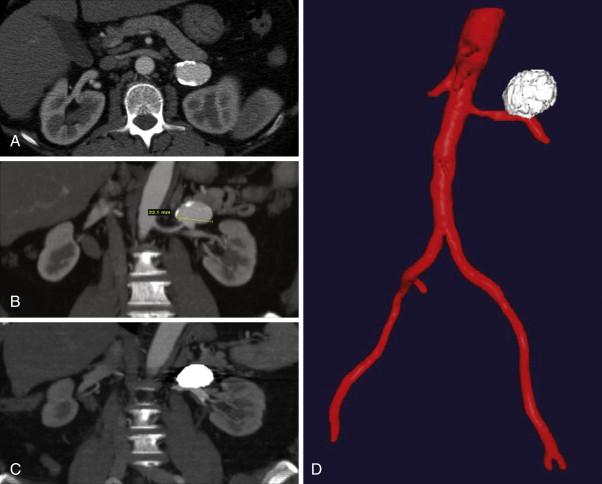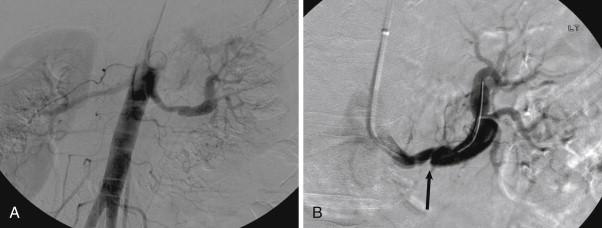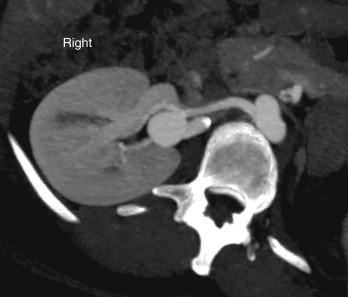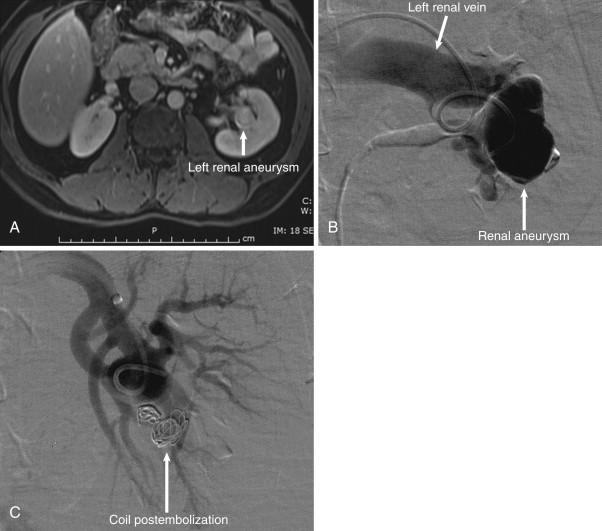Physical Address
304 North Cardinal St.
Dorchester Center, MA 02124
Although renal artery aneurysms located in a distal branch can be sacrificed with little consequence to renal function, centrally located aneurysms posed an initial challenge for the development of successful endovascular treatment options. In 1995 Bui and colleagues described the treatment of a renal artery aneurysm with a stent graft. Although a useful strategy in carefully selected patients, covered stents could not be used for aneurysms located at a bifurcation point, in tortuous vessels, or at more peripheral sites. Indeed, renal artery aneurysms occur predominantly at the renal bifurcation or in the first-order renal artery branches. Moreover, because most renal artery aneurysms are large necked or fusiform, traditional coil embolization is associated with significant potential for coil migration and occlusion of the parent artery. In response to this challenge, stent-assisted embolization, in which coils are delivered to the aneurysm through the struts of a stent in the parent vessel, was first described in 2008 for the treatment of renal aneurysms. Endovascular repair is the predominant treatment for renal artery aneurysms. Although current data suggest that both short- and intermediate-term outcomes of endovascular interventions are excellent, long-term durability remains to be determined.
Aneurysms of the renal artery and its branches are uncommon, occurring in less than 0.1% of the general population and are often discovered incidentally through computed tomography (CT) imaging. Renal aneurysms may present more frequently among women in the sixth decade of life and may be related to fibromuscular dysplasia, atherosclerosis, trauma, or mycotic infection. Renal aneurysms are also observed with vasculitis, such as Takayasu or Behçet disease and Marfan syndrome or neurofibromatosis. Rupture is the main complication.
Aneurysms larger than 2 cm and all renal aneurysms in women considering future pregnancy or in a solitary kidney are considered appropriate for repair due to the risk of rupture. Although 2 cm has been used as the threshold for treatment, even smaller aneurysms can rupture or may cause renovascular hypertension by direct compression of the main renal artery or branch vessel. Renal aneurysms may also embolize to terminal vessels, causing renal infarcts with pain, or may be associated with an arteriovenous fistula.
Patients are symptomatic in fewer than 50% of cases undergoing repair.
Preoperative imaging is critical in determining the type of endovascular repair that can be performed. Three-dimensional (3D) CT angiography or magnetic resonance angiography can define the relationship of the aneurysm to the surrounding branch vessels or the surrounding renal parenchyma. CT angiography can also reveal the extent of calcification in the aneurysm sac and adjacent arteries. Once occlusion coils or stents have been placed, artifact may limit the ability of CT angiography or magnetic resonance angiography to evaluate aneurysm exclusion ( Fig. 39-1 ).

Conventional angiography may provide additional information, such as the association of the renal artery aneurysm with an arteriovenous fistulae, or define entry site tears in patients with renal artery dissection associated with aneurysmal dilatation ( Fig. 39-2 ).

A brachial approach may be needed in severely caudally angulated renal arteries. Many devices needed for treating renal aneurysms require a 7-Fr sheath with open repair of the brachial artery.
Ipsilateral oblique images are critical for identifying occult ostial stenosis and for ensuring that the aneurysm does not obscure the true length or the neck of the aneurysm.
Care must be taken when crossing the aneurysm to avoid rupture of the vessel or embolization of mural thrombus.
Renal artery aneurysms occur predominantly at the renal bifurcation or in the first-order renal artery branches ( Fig. 39-3 ). This precludes placement of a covered stent and requires repair with a combination of coil or glue embolization and stenting.

Renal artery aneurysms that arise as a poststenotic dilation, often seen in patients with fibromuscular dysplasia, may benefit from stent grafting to address both the stenosis and the aneurysm.
Peripheral renal artery aneurysms may be treated with distal coil embolization, sacrificing a small amount of renal parenchyma ( Fig. 39-4 ).

Become a Clinical Tree membership for Full access and enjoy Unlimited articles
If you are a member. Log in here